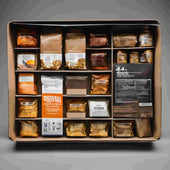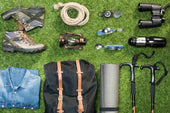The world today is causing humankind uncertainty. But don't you think this has been the case since day one?
Nevertheless, focusing on what we can control is crucial, especially during natural calamities and unexpected catastrophic events.
You and your family could be cut off from your food supply in a world where tragedies can strike without notice.
Given this, food that doesn't necessarily need to be cooked or refrigerated must be stored in the pantry, especially for emergencies that can cut off the power supply.
Get equipped to weather the storm with a well-stocked emergency food stockpile. These foods are calorie-packed and contain nutrients and some fiber enough to get through the uninvited occasion.
What Emergency Foods to Stockpile
Many emergency foods listed below have prolonged expiration dates, so they can be stored for a long time.
Recommendations on how much food is in your stockpile depend on 3-14 days' worth of food.

List everything in your supply and check the expiration dates every six to a year to keep things new.
1. Bottled water
2. Jerky and other dehydrated meats
3. Peanut butter
4. Canned tuna, salmon, chicken, or turkey
5. Whole-wheat crackers
6. Nuts and trail mixes
7. Cereal
8. Granola bars and power bars
9. Dried fruits, such as apricots and raisins
10. Canned vegetables, like green beans, carrots, and peas
11. Canned soups and chili
12. Sugar, salt, and pepper
13. Sports drinks, such as Gatorade or Powerade
14. Powdered milk
15. Multivitamins
Why Using Frozen Food is Not the Answer
Food stored in refrigerators is the first to spoil during a power outage.
After a prolonged power outage, rely on something other than smell to judge whether or not food in the refrigerator can be saved.
Frozen food does not destroy microorganisms but renders them inactive. However, these microorganisms are likely to grow when the food is thawed.
Fruits and vegetables have a mushy/soggy feel because water expands when frozen, just like other liquids.
Things to Buy Just Before an Emergency
There is still time to hurry to the store and get fresh produce and other items with shorter shelf lives if you have received an adequate warning that a storm is approaching.
You can replace all that commercial food with most of these foods, which will last at least a week after purchase.

If your local farmers' market is open, stop by. The produce there is fresher than at a conventional supermarket, giving your fruits and vegetables an extra few days of shelf life.
Apples
Avocados
Citrus fruits, such as oranges and grapefruits
Cucumbers and summer squash
Potatoes, sweet potatoes, and yams
Tomatoes
Winter squash
Hard, packaged sausages, such as soppressata and pepperoni
Signs You Should Start Your Emergency Foods List
Food may need improvement despite all of your measures. These are some of the indications you should watch out for to ensure your food supplies are nutritious and safe to consume:
- Expiration date passed
- Food odors or offensive odors
- Cans with a dent
- Bulging lids
- Cans with rust
- Food with foam on top of it
- The cans are leaking juice or food
Make a list of the foods you eat, the things you can live without, and the amount of money you're willing to spend to have an emergency food guide on hand.
Purchase in bulk, especially during discounts and sales. This will make your purchases more reasonable and ensure consistency in your food rations.
Understanding proper food and water storage techniques will help you cope with the stress and discomfort that an emergency might cause.
Always stock up on ingredients you frequently prepare. This way, you can continue rotating items in your daily life.
Always adhere to the "first in, first out" (FIFO) guideline while creating an emergency food list. Always put older food items in front or on top so they are utilized first, and label your food with the dates you bought it.
Additional Food Advice for an Emergency
• How do you know what is safe to eat from the refrigerator if the electricity goes out?
• You could still be able to cook or heat your food if you don't have electricity.
• Family with special needs.
• Opt for canned goods in an area with a high risk of flooding.
Taking charge at home

If you and your family have limited access or decide to remain at home during or after an emergency, consider several things. This will help you manage your food supply as effectively as possible.
- Use frozen or chilled food items first if the power is out:
- After a power outage, chilled food will be safe for up to 4 hours.
- After a power outage, frozen meals will be safe for up to a day.
- Food may stay safer for longer if the refrigerator/freezer door is kept closed as much as possible, but a thermometer should be used to ensure the food's temperature has not risen over 6°C.
- Newly prepared foods kept at room temperature (not in the refrigerator) are safe for up to four hours after cooking.
- Before consuming long-lasting products, eat other perishable foods (such as bread and fresh fruits and vegetables).
- Aim for ready-to-eat items that don't need to be cooked when stocking your cupboard (in case the gas or electricity supply is interrupted).
- Based on how long you anticipate being restricted at home, ration your food and water supplies.






















































